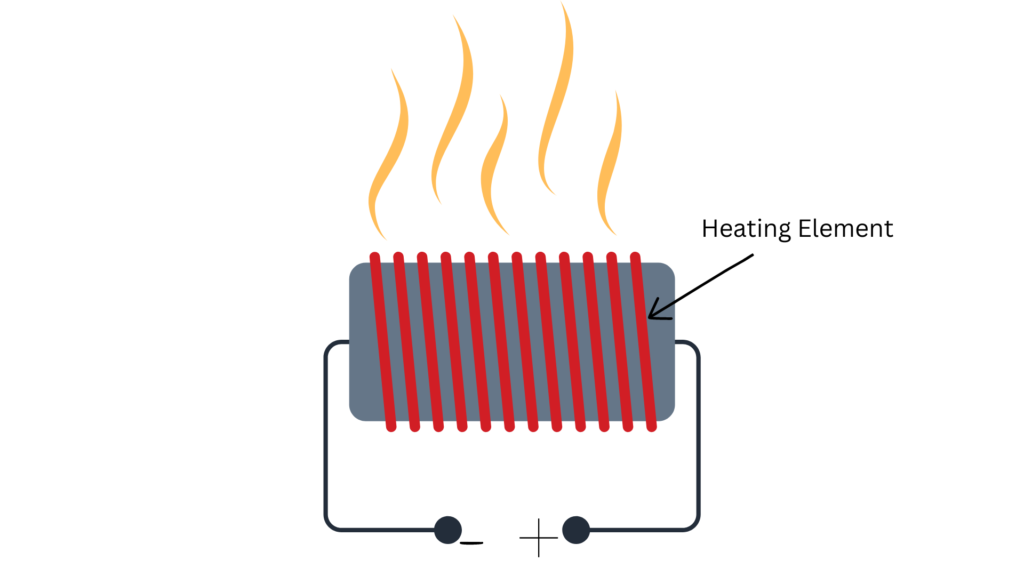How Do Electric Heaters Work ? Quick Guide

Introduction
Electric heaters have become a popular choice for providing warmth and comfort in homes and workplaces. These devices offer a convenient and efficient way to generate heat without the need for an open flame or the use of combustible fuels. But have you ever wondered how electric heaters actually work? In this article, we will explore the science behind how do electric heaters works and how they produce the cozy warmth we desire.
How Do Electric Heaters Work ?
- Heating Elements: The core component of an electric heater is the heating element. This element is typically made of a high-resistance material, such as nichrome wire or ceramic, which has a property known as electrical resistance. When an electric current passes through the heating element, it encounters resistance, causing the element to heat up. The resistance generates heat energy, which is then transferred to the surrounding environment.
- Electrical Circuit: To power the heating element, electric heaters are connected to an electrical circuit. The circuit consists of several key elements:
- Power Source: Electric heaters are typically connected to a power source, such as a wall outlet or electrical wiring within a building. The voltage provided by the power source determines the amount of electrical energy available to the heater.
- Thermostat: Many electric heaters are equipped with a thermostat, which controls the temperature of the heater. The thermostat measures the ambient temperature and regulates the flow of electricity to the heating element accordingly. When the temperature drops below the desired level, the thermostat signals the heater to increase the electrical current flowing through the heating element, generating more heat. Once the desired temperature is reached, the thermostat reduces or cuts off the current to maintain the desired warmth.
- Circuit Breaker: Electric heaters often include a circuit breaker or fuse as a safety feature. These devices monitor the electrical current flowing through the circuit and automatically shut off the power in the event of an overload or short circuit. This helps prevent overheating and potential electrical hazards.
- Heat Transfer: Once the heating element generates heat, the process of heat transfer begins. There are three primary modes of heat transfer involved in electric heaters:
- Conduction: Conduction is the transfer of heat through direct contact. Electric heaters are designed with conductive materials, such as metal fins or ceramic plates, that come into contact with the heating element. These materials absorb the heat and transfer it to the surrounding air.

- Convection: Convection is the transfer of heat through the movement of fluids or gases. As the air near the heater comes into contact with the heated surfaces, it absorbs the heat and becomes less dense. The warm air rises, creating a convection current that circulates the heat throughout the room. This process helps distribute the warmth evenly.
- Radiation: Radiation is the transfer of heat through electromagnetic waves. While most electric heaters primarily rely on conduction and convection for heat transfer, some models also emit infrared radiation. Infrared radiation directly heats objects and people in its path, providing immediate warmth.
- Efficiency and Safety Considerations: Electric heaters are generally considered efficient because they convert almost all the electrical energy into heat. Unlike combustion-based heating systems, such as gas or oil heaters, electric heaters do not produce any exhaust gases, making them safe to use indoors. However, it’s important to note that electric heaters can consume significant amounts of electricity, so using them judiciously and considering energy-saving features, like programmable thermostats and timer functions, can help manage energy consumption.
Application and Usage of Electric Heaters
Electric heaters have a wide range of applications and can be used in various settings to provide warmth and comfort. Here are some common applications and uses of electric heaters:
- Residential Use:
- Heating Homes: Electric heaters are commonly used to supplement or provide primary heating in residential properties. They can be used in individual rooms, such as bedrooms, living rooms, or bathrooms, to provide localized warmth. Electric space heaters are also used in homes that do not have central heating systems or to enhance heating in specific areas.
- Basements and Garages: Electric heaters are often used in basements, garages, and other unheated spaces where additional warmth is desired. They help maintain comfortable temperatures and prevent freezing in colder months.
- Portable Heating: Portable electric heaters are popular for their convenience and flexibility. They can be easily moved from room to room, allowing users to heat specific areas as needed.
- Commercial and Workplace Use:
- Offices: Electric heaters are commonly used in offices to provide supplemental heating during colder months. They help create a comfortable working environment and allow employees to adjust the temperature to their preference.
- Retail Spaces: Electric heaters are used in retail stores, restaurants, and other commercial spaces to provide warmth for customers and employees. They are particularly useful in drafty areas or near entrances where cold air can enter.
- Construction Sites: Electric heaters are frequently used on construction sites to provide temporary heating for workers during colder seasons. They help maintain a comfortable working environment, ensuring productivity and worker well-being.
- Outdoor and Recreational Use:
- Patios and Outdoor Spaces: Electric patio heaters are popular for outdoor entertaining areas, restaurants, and cafes. They provide warmth for outdoor seating areas, extending the usability of outdoor spaces during cooler evenings or seasons.
- Camping and RVing: Electric heaters designed for camping or RV use can be powered by battery or generator systems. They provide a convenient source of heat in tents, cabins, or recreational vehicles, ensuring comfort during outdoor adventures.
- Industrial and Commercial Applications:
- Industrial Spaces: Electric heaters are utilized in industrial settings, such as warehouses, factories, and workshops, to provide localized or general heating. They help maintain appropriate temperatures for processes, equipment, and worker comfort.
- Greenhouses: Electric heaters are used in greenhouses to provide the necessary warmth for optimal plant growth during colder months. They help maintain consistent temperatures, preventing damage to plants.
- Cold Storage Facilities: Electric heaters can be used in cold storage facilities to prevent freezing and maintain the required temperature for stored goods.
- Specialized Applications:
- Pet Areas: Electric heaters are often used to provide warmth for pet areas, such as dog houses or outdoor enclosures, ensuring the comfort and well-being of pets during colder weather.
- Medical Settings: Electric heaters may be used in medical facilities or patient rooms to provide localized warmth for patients, particularly those who are more susceptible to cold temperatures.
It’s important to note that when using electric heaters, safety precautions should be followed, such as keeping them away from flammable materials, using them on stable surfaces, and ensuring proper ventilation. Additionally, energy-saving practices, such as using programmable thermostats or timers, can help manage energy consumption and optimize efficiency.
Conclusion
Electric heaters provide a reliable and convenient source of warmth, utilizing the principles of electrical resistance, heat transfer, and temperature control. By employing heating elements that generate heat when an electric current passes through them, these devices effectively warm the surrounding air through conduction, convection, and, in some cases, radiation. Understanding the science behind electric heaters allows us to appreciate their efficiency and safety, providing comfort and coziness during colder seasons. Whether you’re using an electric heater at home, in the office, or any other indoor space, you can now appreciate the technology and mechanisms at work, keeping you warm and comfortable.

With a degree in Electrical Engineering and years of hands-on experience in the tech industry, passionate to provide readers with insightful reviews. From smartphones and laptops to smart home devices and emerging technologies, he navigates the ever-evolving tech landscape, offering in-depth analyses and honest opinions.

![3d_printed_art_01[1]](https://techreviewly.com/wp-content/uploads/2025/08/3d_printed_art_011-300x225.jpeg)
![a_women_wearing_a_smart_watch_01[1]](https://techreviewly.com/wp-content/uploads/2025/08/a_women_wearing_a_smart_watch_011-300x169.jpeg)






